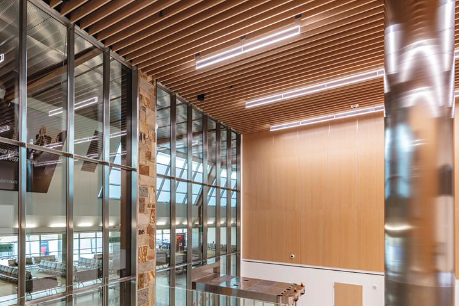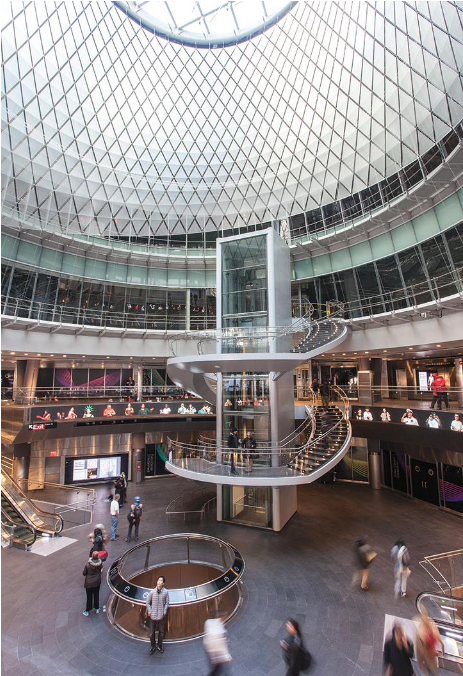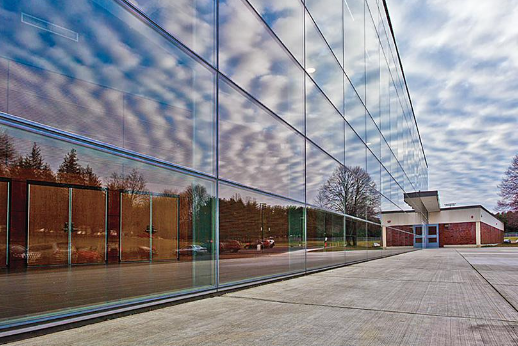The benefits of steel framing in curtain wall systems.
Whether used within the built environment or as an exterior façade, curtain walls made with transparent glazing can enhance the overall design of a building by improving access to daylight and helping to stabilize interior temperatures with U-values as low as 0.19. While discussion around these systems tends to focus on the glass, the framing systems are an equally important aspect to consider.
Choosing the right framing material can help optimize the benefits of a transparent curtain wall system. For example, the recent terminal expansion of Oklahoma City’s Will Rogers World Airport turned to cold-formed, structural steel framing systems to provide the largest possible spans and maximize the glazing area. However, the benefits of steel framing extend beyond strength to include improved thermal performance and system durability.
Increases Free Spans
Steel framing offers almost three times the strength of aluminum systems with a Young’s modulus of 29 million pounds per square inch (psi)—compared to aluminum’s 10 million psi. With greater strength comes larger spans and larger panels, or lites, of glass with similar shapes. Not only does this maximize the glazing area for better views and a greater percentage of visible light transmission, but it allows thicker glazing infills—over 3 inches (in) for some systems—which can help accommodate fire-rated glass when needed.

Further, steel frames can span heights much more significant than aluminum systems without the need for bulky and expensive support systems. Given a designed wind load of 30 pounds per square foot (psf), 5-foot (ft) vertical to vertical module spacing, and using captured rectangular verticals, steel curtain wall framing can span heights up to 21.41 ft without reinforcement (compared to aluminum’s 12.5 ft). The Will Roger World Airport’s architectural team used this strength in conjunction with the building’s intermediate vertical structural members for anchorage to span heights of 33 ft without greatly increasing the frame’s dimensions.

Improves Thermal Performance
Low-emissivity, double or triple-glazed units, and other energy-efficient glass can significantly improve the thermal performance of a glass curtain wall system. In addition to providing the strength to hold these types of glazing, steel framing also contributes to stable interior temperatures. Steel’s thermal conductivity is approximately 74 percent less than aluminum’s, reducing the amount of heat transferred through the framing.
Comparable to both glass and concrete, steel’s thermal expansion coefficient (0.00065 inch/inch/degree in Fahrenheit (in/in/deg F)) is almost half that of aluminum’s (0.00128 in/in/deg F). Reducing the amount of expansion the framing undergoes helps ensure a sound build- ing envelope as temperatures change. Likewise, steel frames require fewer expansion joints, resulting in a more tightly knit curtain wall system. All these qualities improve the insulative capabilities of exterior curtain walls, decreasing energy consumption from HVAC systems. This works with daylight access, which limits the amount of electric lighting needed, to help buildings more readily achieve LEED credits.
Provides a Close Visual Match Between Fire-Rated and Non-Rated Systems
Cold-formed, structural steel framing can extend its benefits beyond a singular application to enhance a building’s design. Most notably, due to the strength and durability of these systems, they can provide a close visual match between non-rated and rated curtain walls.
Steel framing can be fire-rated for up to two hours if a fire rating is required. For fire-rated applications, the glass becomes heavier (and often thicker). In response, the frames must be stronger. In the past, this often meant enlarging a frame’s width and depth or adding either internal or external reinforcements to the system. Steel framing can provide fire-rated curtain walls with the strength to support large and heavy lites without dramatically increasing frame size or compromising the fire rating of the entire system.
This results in a narrow-profile frame that does not stand out compared to adjacent systems. For example, the Fulton Center in New York City used a fire-rated steel framing system to meet the requirements of its upper-level curtain walls while maintaining a seamless aesthetic with the non-rated curtain walls of the lower levels.
Exceed Historical Limitations
With all these benefits, some may wonder why steel is not used more prominently.
Historically, the use of steel has been limited by concerns about corrosion in exposed conditions and an inability for manufacturers to form mullions precisely, resulting in bulkier frames. However, galvanizing these systems before assembly, along with both liquid and powder coat finishes, provides durable layers of protection against rust without compromising the design versatility of these systems.
Additionally, many steel systems rely on rain-screen or pressure equalized principles for managing air and water resistance. For these systems, the primary seal at the back of the glazing pocket is extruded, with continuous gasketing across the face of all framing members. It provides increased air and water resistance. This bolsters the ability of a system to ensure a sealed building.
All Framed Up
Transparent curtain walls provide building professionals with many design possibilities—some of which were not possible even 20 years ago. While much of the conversation around these systems has understandably centered on glass, framing materials play an integral role in a curtain wall’s ability to meet and exceed design specifications.

When steel framing is used, designers and engineers can increase the lite size and span height without vastly changing the frame shape, thereby maximizing the glazing area. Steel’s thermal performance capabilities also help curtain wall assemblies more significantly contribute to sustainable building initiatives like LEED and the Living Building Challenge.■
